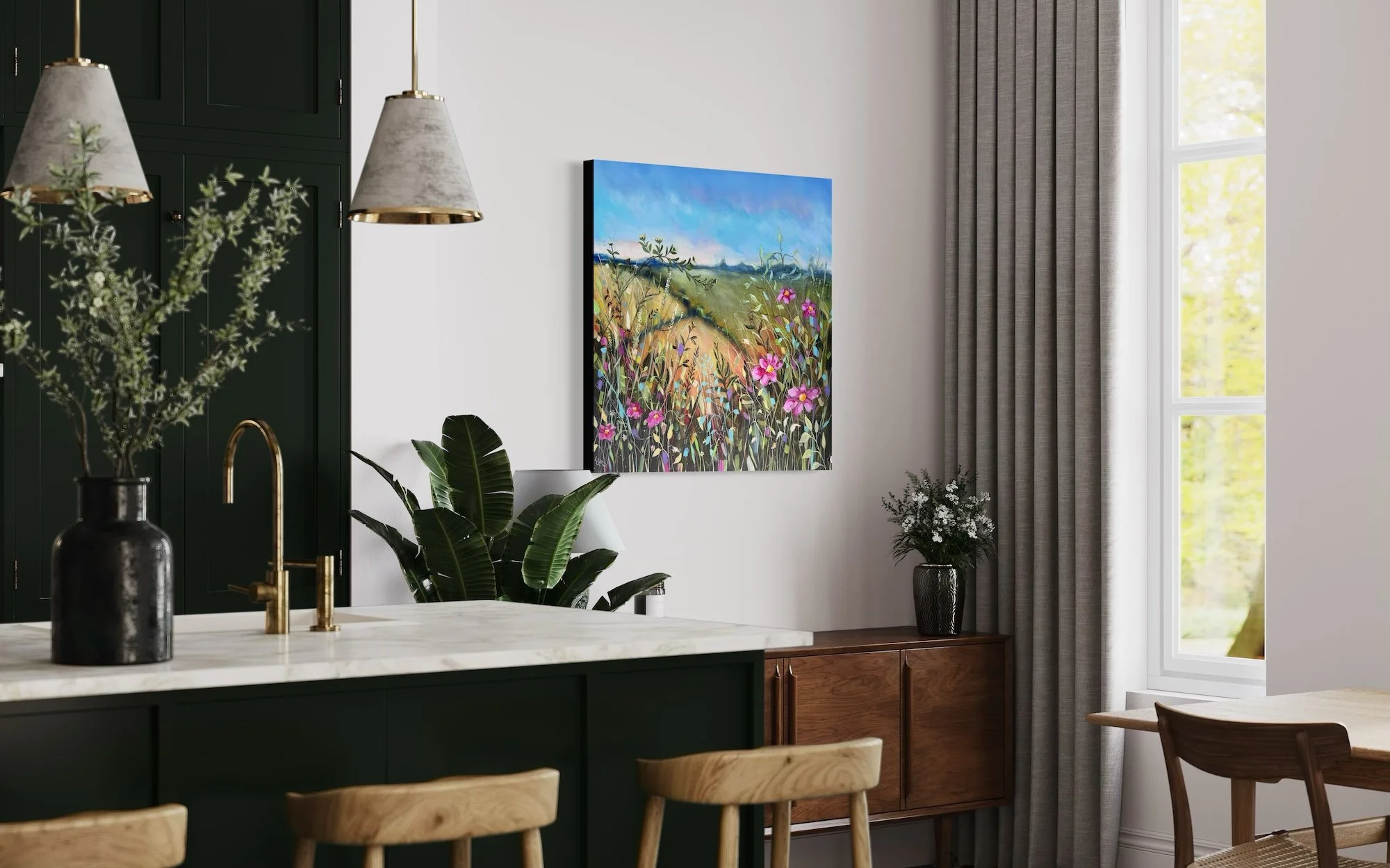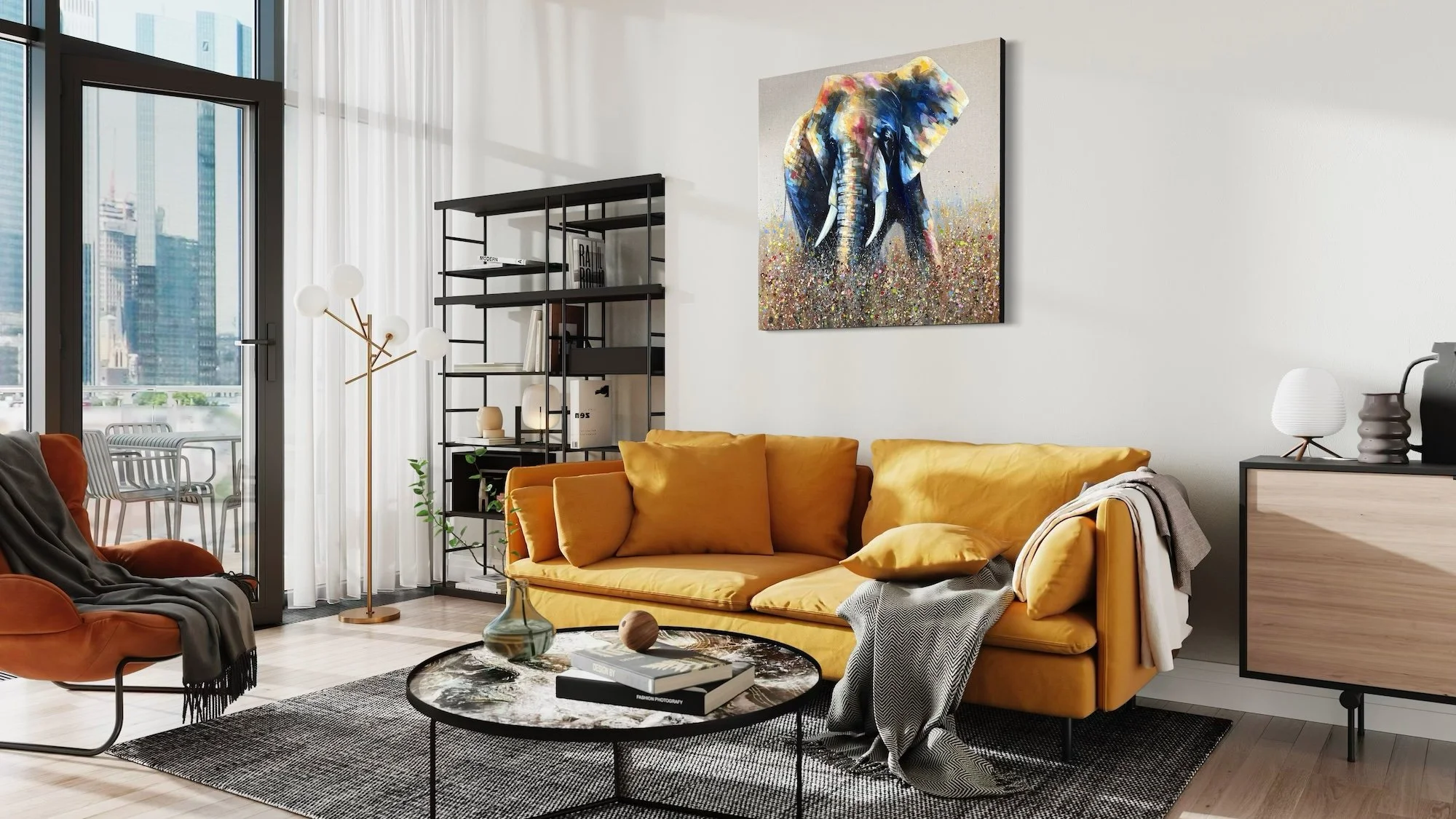Art buyers guide for beginners. My TOP 10 Tips...
Do you fancy treating yourself to some super art, but too afraid to take the plunge? Read on for my simple guide to getting the art you want without feeling bamboozled.
This week’s blog is going to give you the confidence to go and buy some great art.
Remember, try to look online for artists in your area first, then visit their studio. It's a great way to find out what you like without pressure. If you can't find an artist you like, in your area, the next plan is to visit a small gallery (nothing too intimidating) or go to an art fair.
Once you've gone to the studio/artfair or gallery- follow my top ten rules to help you select art. You should really enjoy the process of buying yourself some gorgeous new art.
Akiki framed print of a lion
1. Do you love it?
For me absolute rule number one is - Only by art if you love it! You might have to compromise with your husband/wife or you might have to think a bit carefully about how much you love it but broadly speaking if you love the art you can't go far wrong. If one of you loves it and the others is kind of OK about it that’s good too!
2. Where is it going to go?
You might have a plan when you walk into a gallery or an art fair that you're looking for a piece of work for the lounge. This is quite a good strategy as you can start to visualise where the work of art might go. this might help you think about what would work in the space, a big statement to complete the room piece or something more subtle. You might be renovating a room and you want the perfect finishing touch, having this in mind can really help you make up your mind.
“ The fields we found”
3. Size matters.
Broadly speaking it doesn't really matter if you have a large piece or a series of small pieces to start your collection. But if you have, for instance, wall lights in your home you might find that large artwork doesn't fit in the room in quite the same way you had planned. Having a maximum size is a good idea. If you don't want to pay for shipping or delivery having a clear idea of the largest painting that will fit in your car is a good plan too! Very often artists will be able to arrange shipping for you if you are buying a very large piece that simply won't fit in the car.
4. Colour
I think this can be an automatic decision. Sometimes there are colours we are drawn too. They don't have to match the sofa, in fact they might be opposites. If you have a white or pastel wall having a punch of colour might be jus the thing. Or maybe you love the pale space and you want something harmonious. Besides, your natural liking for a colour palette will come through anyway- you're going to be back with rule number one quite frankly! Enjoy the colours, forget fashioned go with what speaks to you.
5. Have a budget
It really doesn't matter how much money you spend provided you spend what you can afford. People seem to think the art world is about tens of thousands of pounds or even millions of pounds. At most of the galleries I go and on my own site you can start with an original at £150. That will be quite a small painting, but it's original and it's unique and it's a great place to start.
Since publishing my prints, some people have started their collection with a stunning framed print and then moved onto originals when they become more sure of their own style.
Quality is key. If you your budget is only running to prints rather than originals right now, that's fine, but really look for a quality image.
Think about it; you might have spent over £10,000 redecorating your kitchen, you can have a superb statement piece for maybe a few hundred pounds or start a series of little originals instead.
Don't be intimidated, its your home, make it beautiful in your own way.
6. Try not to worry about investment.
You might get lucky, you might find a new emerging artist, buy their work for only a couple of hundred pounds, and then in two years time discover that their work is going for 10 times the price! It really might happen. Lots of successful artists at very least find their prices going up after only a few years into their career. However when you're buying work for less than £1000 try not to worry about what it will be worth in a few years time. Just make sure that you're going to love it in your own home that will be enough.
7. Quality is key
It's that word again, quality.
Feel free to ask the artist anything about the quality of the materials they use. Find out about pigments, ask them about colourfastness. Okay so you might not be able to hang a £500 work of art in 500 years time but you certainly don't want the colour to fade in less than 10 years. I make a point of using the best quality paints, the pigments are strong and the colour won't fade.
8. Negotiate, but don't be offended if you get a "no"
Some artists will not negotiate at all. Some High Street galleries will not negotiate at all. Don't be offended if people say “The price is the price please don't ask for a discount”. ITs fair enough. However if you buy more than one work of art you may well find that artists have a little bit of wriggle room and might give you say a 10% discount because you're buying more than one piece. The worst they can do is say no, if they do say no please don't be offended smile sweetly and say “It was worth a try”!
9. Look after your art
Recently I sold a very large piece to a couple and they said “Is it true I can’t hang this over a radiator?”
Well here's the deal; in my kitchen I have a very large oil painting of Stonehenge and it hangs directly over radiator, it's opposite the oven, it gets steam and heat and cold and sunshine on it
in the morning. Over a decade of being in the spot and it still looks like new! However if I had a work of art that I've spent a lot of money on, or if I had an old work of art that might be a little more fragile I would not dream of putting it over a radiator- as a rule of thumb you have to be careful with extremes of heat. Steering clear from the radiator and direct sunlight is a good idea.
Watercolours are significantly more fragile and definitely not be placed in a damp rooms. Also be very careful about direct sunlight. Okay in our climate we’re not exactly living in Greece, the sun really isn't so strong and it doesn't shine for that much of the year , but sun will fade out paint incredibly rapidly if given the chance. Just think about the fading on your curtains or fabrics in a sunny room - that could happen to your painting so do be careful. If in any doubt at all ask the artist. And if you move the artwork to a new room, still feel free to email your artist years after you've bought it they will be happy to help - honestly we really will.
10. Don’t be scared of being a numpty!
I think the single biggest reason people don't buy art directly from artist is that they are frightened of looking like an idiot! You are not an idiot! It's your money and it is your house and it's up to you how you decorate it. Tell the artist what you're looking for maybe even tell them what work of theirs you like and what else you might like to have. Artists will be helpful to you at art fairs. I've even recommended other artists to potential clients because I knew exactly what they wanted from their description and I knew where they needed to go to find it. Gallery owners will do the same, they will try to match you up with the kind of art that you want, that's part of what you're paying for, don't be bullied and don't worry- it's your money and your house, buy what you love!




